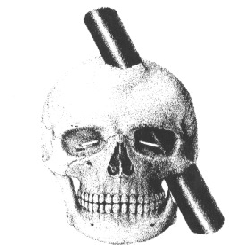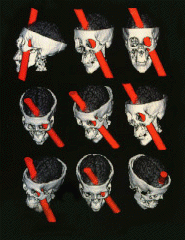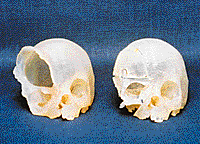

 Phineas Gage was a young railroad construction supervisor in the Rutland and Burland Railroad
site, in Vermont. In September 1848, while preparing a powder charge for blasting a rock, he inadvertently tamped
a steel rod into the hole. The ensuing explosion projected the tamping rod,
with 2.5 cm of diameter and more than one meter of lenght against his skull, at a high speed. The rod entered his
head trhough his left cheek, destroyed his eye, traversed the frontal part of the brain, and left the top of the
skull at the other side. Gage lost consciousness immediately and started to have convulsions. However, he recovered
conscience moments later, and was taken to a local doctor, Jonh Harlow, who took care of him. Amazingly, he was
talking and could walk. He lost a lot of blood, but after a bout with infection, he not only survived to the ghastly
lesion, but recovered well, too.
Phineas Gage was a young railroad construction supervisor in the Rutland and Burland Railroad
site, in Vermont. In September 1848, while preparing a powder charge for blasting a rock, he inadvertently tamped
a steel rod into the hole. The ensuing explosion projected the tamping rod,
with 2.5 cm of diameter and more than one meter of lenght against his skull, at a high speed. The rod entered his
head trhough his left cheek, destroyed his eye, traversed the frontal part of the brain, and left the top of the
skull at the other side. Gage lost consciousness immediately and started to have convulsions. However, he recovered
conscience moments later, and was taken to a local doctor, Jonh Harlow, who took care of him. Amazingly, he was
talking and could walk. He lost a lot of blood, but after a bout with infection, he not only survived to the ghastly
lesion, but recovered well, too.
 Months later, however, Gage began to have startling changes in personality in mood. He
became extravagant and anti-social, a fullmouth and a liar with bad manners, and could no longer hold a job or
plan his future. "Gage was no longer Gage", said his friends of him. He died in 1861, thirtheen
years after the accident, penniless and epileptic, and no autopsy was performed on his brain. His former physician,
John Harlow, interviewed his friends and relatives, and wrote two, reporting Gage's reconstructed medical history,
one in 1948, entitled "Passage
of an Iron Rod Through the Head",
and another in 1868, titled "Recovery
from the Passage of an Iron Rod Through the Head".
Months later, however, Gage began to have startling changes in personality in mood. He
became extravagant and anti-social, a fullmouth and a liar with bad manners, and could no longer hold a job or
plan his future. "Gage was no longer Gage", said his friends of him. He died in 1861, thirtheen
years after the accident, penniless and epileptic, and no autopsy was performed on his brain. His former physician,
John Harlow, interviewed his friends and relatives, and wrote two, reporting Gage's reconstructed medical history,
one in 1948, entitled "Passage
of an Iron Rod Through the Head",
and another in 1868, titled "Recovery
from the Passage of an Iron Rod Through the Head".
Phineas Gage became a classical case in the textbooks of neurology. The part of the brain which he had lost, was forever associated to the mental and emotional functions which he had lost. Harlow believed that, as he wrote that "The equilibrium between his intellectual faculties and animal propensities seems to have been destroyed.

 His
skull was recovered however, and preserved
in the Warren Medical Museum of
Harvard University. Much later, two Portuguese neurobiologists, Hanna and Antonio Damasio of the University of Iowa, used computer graphics and neural imaging techniques to plot
the trajectory of the steel rod as it coursed through Gage's brain, and published the results in Science, in 1994. They discovered that most of the damage was done to the ventromedial
region of the frontal lobes on both sides. The part of the frontal lobes responsible for speech and motor functions
was apparently spared, so they concluded that the changes in social behavior observed in Phineas Gage were probably
due to this lesion, because the Damasios have observed the same sort of change in other patients with similar lesions,
causing a defect in rational decision making and the processing of emotion.
His
skull was recovered however, and preserved
in the Warren Medical Museum of
Harvard University. Much later, two Portuguese neurobiologists, Hanna and Antonio Damasio of the University of Iowa, used computer graphics and neural imaging techniques to plot
the trajectory of the steel rod as it coursed through Gage's brain, and published the results in Science, in 1994. They discovered that most of the damage was done to the ventromedial
region of the frontal lobes on both sides. The part of the frontal lobes responsible for speech and motor functions
was apparently spared, so they concluded that the changes in social behavior observed in Phineas Gage were probably
due to this lesion, because the Damasios have observed the same sort of change in other patients with similar lesions,
causing a defect in rational decision making and the processing of emotion.
"Gage's story was the historical beginnings of the study of the biological basis of behavior," said Antonio Damasio.
 To
Know More
To
Know More.
| From: The History of Psychosurgery Author: Renato M.E. Sabbatini, PhD Source: Brain & Mind Magazine, June 1997 |